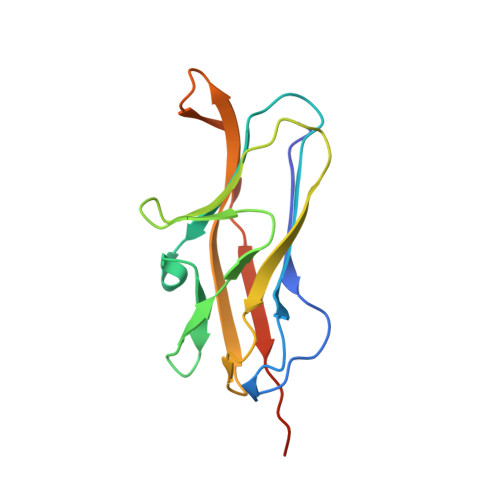Structural basis for the specific recognition of dual receptors by the homopolymeric pH 6 antigen (Psa) fimbriae of Yersinia pestis.
Bao, R., Nair, M.K., Tang, W.K., Esser, L., Sadhukhan, A., Holland, R.L., Xia, D., Schifferli, D.M.(2013) Proc Natl Acad Sci U S A 110: 1065-1070
- PubMed: 23277582
- DOI: https://doi.org/10.1073/pnas.1212431110
- Primary Citation of Related Structures:
4F8L, 4F8N, 4F8O, 4F8P - PubMed Abstract:
The pH 6 antigen (Psa) of Yersinia pestis consists of fimbriae that bind to two receptors: β1-linked galactosyl residues in glycosphingolipids and the phosphocholine group in phospholipids. Despite the ubiquitous presence of either moiety on the surface of many mammalian cells, Y. pestis appears to prefer interacting with certain types of human cells, such as macrophages and alveolar epithelial cells of the lung. The molecular mechanism of this apparent selectivity is not clear. Site-directed mutagenesis of the consensus choline-binding motif in the sequence of PsaA, the subunit of the Psa fimbrial homopolymer, identified residues that abolish galactosylceramide binding, phosphatidylcholine binding, or both. The crystal structure of PsaA in complex with both galactose and phosphocholine reveals separate receptor binding sites that share a common structural motif, thus suggesting a potential interaction between the two sites. Mutagenesis of this shared structural motif identified Tyr126, which is part of the choline-binding consensus sequence but is found in direct contact with the galactose in the structure of PsaA, important for both receptor binding. Thus, this structure depicts a fimbrial subunit that forms a polymeric adhesin with a unique arrangement of dual receptor binding sites. These findings move the field forward by providing insights into unique types of multiple receptor-ligand interactions and should steer research into the synthesis of dual receptor inhibitor molecules to slow down the rapid progression of plague.
Organizational Affiliation:
Laboratory of Cell Biology, Center for Cancer Research, National Cancer Institute, National Institutes of Health, Bethesda, MD 20892, USA.


















